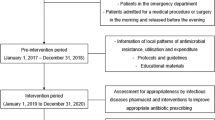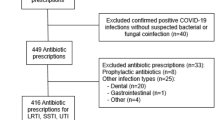Abstract
Background To improve antimicrobial use, incorporation of a pharmacist in antimicrobial stewardship initiatives in the emergency department has been recommended. Recognizing the potential value, a pharmacist-led antimicrobial stewardship (AMS) service which included review and follow up of microbiology results for patients discharged from the pediatric emergency department (PED) with suspected infections was implemented at our local institution. Objective The objective of this study was to evaluate the impact of pharmacists delivering this service compared to usual care. Setting Pediatric emergency department at the IWK Health Centre in Halifax, Canada. Method This study was completed as a retrospective chart review of pediatric patients discharged from the PED 6 months before and after implementation of the pharmacist-led AMS service. Data was extracted from electronic medical records. Data were reported descriptively and compared using a two-sided chi-square test and ordinal logistic regression. Main outcome measures The primary outcome measure was rate of return visits to the PED within 96 h of initial presentation. Results This study included 1070 patient encounters pre-implementation and 1040 patient encounters post-implementation. The rate of return visits to the PED within 96 h was 12.0% (129/1070) pre-implementation vs. 10.0% (100/1049) post-implementation (p = 0.07). The rate of return visits or hospitalization at 30 days was 22.1% (237/1070) pre-implementation compared to 19.9% (207/1040) in the post-implementation phase (p = 0.21). Inappropriate antimicrobial therapy was identified more often in the pre-implementation phase (7.0%, 68/975) vs. the post-implementation phase (5.0%, 46/952), p = 0.047. Time to notification within the first day after discharge occurred more frequently in the post-implementation phase (53.3%, 80/150) as compared to the pre-implementation phase (40.3%, 52/129, p = 0.0298). Conclusion Although this pharmacist-led AMS service did not significantly affect the rate of return visits or hospitalization, it may have led to more judicious use of antimicrobial agents and faster time to notification.



Similar content being viewed by others
References
Public Health Agency of Canada. Tackling antimicrobial resistance and antimicrobial use: a Pan-Canadian framework for action [Internet]. 2017 [cited 20 Feb 2019]. 44p. Available from: https://www.canada.ca/en/health-canada/services/publications/drugs-health-products/tackling-antimicrobial-resistance-use-pan-canadian-framework-action.html.
Fishman N, Patterson J, Saiman L, Srinivasan A, Trivedi KK, van Schooneveld T, et al. Policy statement on antimicrobial stewardship by the Society for Healthcare Epidemiology of America (SHEA), the Infectious Diseases Society of America (IDSA), and the Pediatric Diseases Society (PIDS). Infect Control Hosp Epidemiol. 2012;33:332–7.
Accreditation Canada. Required Organizational Practices (ROPs). Accreditation Canada [Internet]. 2017 [cited 20 Feb 2019]; [about 2 screens]. Available from: https://accreditation.ca/required-organizational-practices/.
Davey P, Marwick CA, Scott CL, Charani E, McNeil K, Brown E, et al (2017) Interventions to improve antibiotic prescribing practices for hospital inpatients. Cochrane Db Syst Rev 2:CD003543.
Barlam TF, Cosgrove SE, Abbo LM, MacDougall C, Schuetz AN, Septimus EJ, et al. Implementing an antibiotic stewardship program: guidelines by the infectious disease Society of America and the Society for Healthcare Epidemiology of America. Clin Infect Dis. 2016;62:e51–77.
Losier M, Ramsey TD, Wilby KJ, Black EK. A systematic review of antimicrobial stewardship interventions in the emergency department. Ann Pharmacother. 2017;51(9):774–90.
Bishop BM. Antimicrobial stewardship in the emergency department: challenges, opportunities, and a call to action for pharmacists. J Pharm Pract. 2015;29(6):556–63.
May L, Cosgrove S, L'Archeveque M, Talan DA, Payne P, Jordan J, et al (2013) A call to action for antimicrobial stewardship in the emergency department: approaches and strategies. Ann Emerg Med. 2013; 62(1):69–77e2.
Randolph TC, Parker A, Meyer L, Zeina R. Effect of a pharmacist-managed culture review process on antimicrobial therapy in an emergency department. Am J Health-Syst Pharm. 2011;68:916–9.
Baker SN, Acquisto NM, Ashley ED, Fairbanks RJ, Beamish SE, Haas CE. Pharmacist-managed antimicrobial stewardship program for patients discharged from the emergency department. J Pharm Pract. 2012;25(2):190–4.
Miller K, McGraw MA, Tomsey A, Hegde GG, Shang J, O’Neill JM, et al. Pharmacist addition to the post-ED visit review of discharge antimicrobial regimens. Am J Emerg Med. 2014;32(10):1270–4.
Santiago RD, Bazan JA, Brown NV, Adkins EJ, Shrik MB. Evaluation of pharmacist impact on culture review process for patients discharged from the emergency department. Hosp Pharm. 2016;51(9):738–43.
Davis LC, Covey RB, Weston JS, Hu BBY, Laine G (2016) Pharmacist-driven antimicrobial optimization in the emergency department. Am J Health Syst Pharm;73(5 Suppl 1):S49–56.
Dumkow LE, Beuschel TS, Brandt KL. Expanding antimicrobial stewardship to urgent care centers through a pharmacist-led culture follow-up program. Infect Dis Ther. 2017;6(3):453–9.
Xi Zhang, Rowan N, Pflugeisen BM, Alajbegovic S. Urine culture guided antibiotic interventions: a pharmacist driven antimicrobial stewardship effort in the ED. Am J Emerg Med. 2017;35:594–8.
Canadian Pharmacists Association. Pharmacists’ Expanded Scope of Practice [Internet]. 2019 [Cited 27 Sept 2019]; Available from: https://www.pharmacists.ca/pharmacy-in-canada/scope-of-practice-canada/.
Nova Scotia College of Pharmacists. Standards of Practice: Prescribing Drugs [Internet]. 2019 [Cited 17 Jul 2019]; Available from: https://www.nspharmacists.ca/wp-content/uploads/2016/05/SOP_PrescribingDrugs.pdf.
IWK Health Centre. Children’s Health Services Directory. IWK [Internet]. 2019 [cited 20 Feb 2019];[about 1 screen]. Available from: https://www.iwk.nshealth.ca/childrens-health/services/#/childrens-health/services/emergency-department.
Author information
Authors and Affiliations
Corresponding author
Ethics declarations
Funding
This study was funded by the Dalhousie Pharmacy Endowment Fund.
Conflicts of Interest
Authors of this manuscript have no conflicts of interest to disclose.
Additional information
Publisher's Note
Springer Nature remains neutral with regard to jurisdictional claims in published maps and institutional affiliations.
Rights and permissions
About this article
Cite this article
MacMillan, K.M., MacInnis, M., Fitzpatrick, E. et al. Evaluation of a pharmacist-led antimicrobial stewardship service in a pediatric emergency department. Int J Clin Pharm 41, 1592–1598 (2019). https://doi.org/10.1007/s11096-019-00924-1
Received:
Accepted:
Published:
Issue Date:
DOI: https://doi.org/10.1007/s11096-019-00924-1




